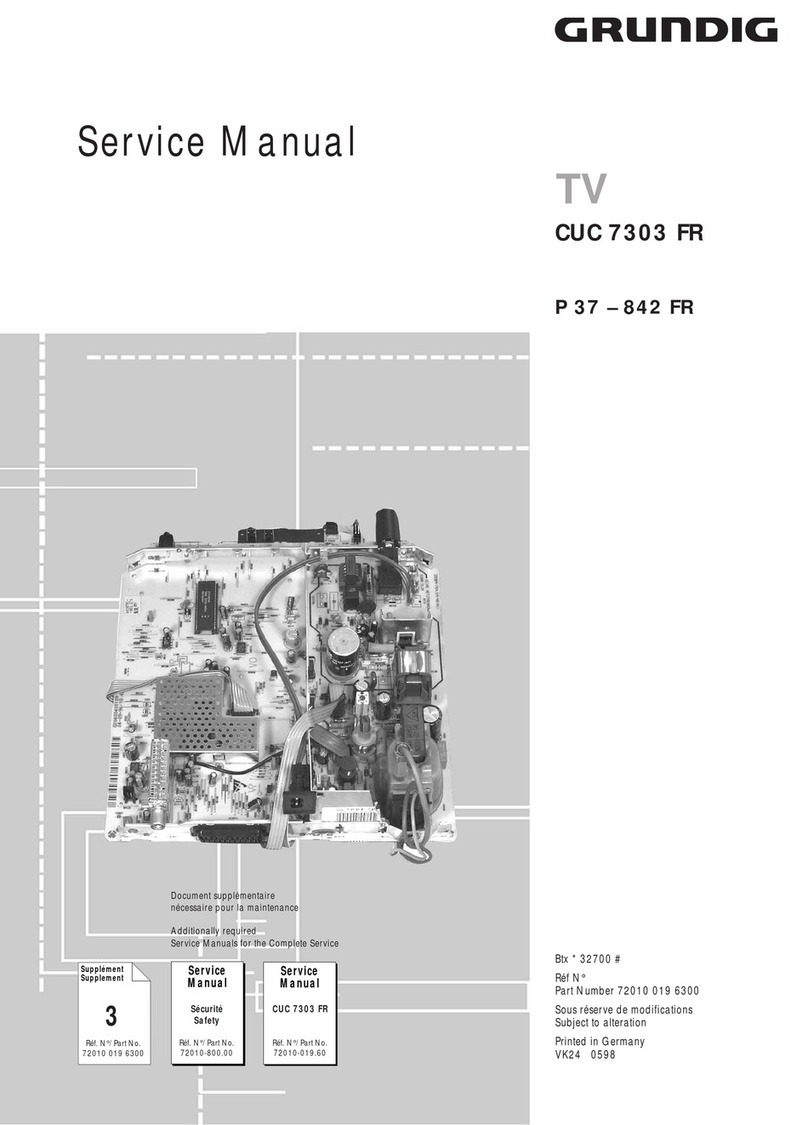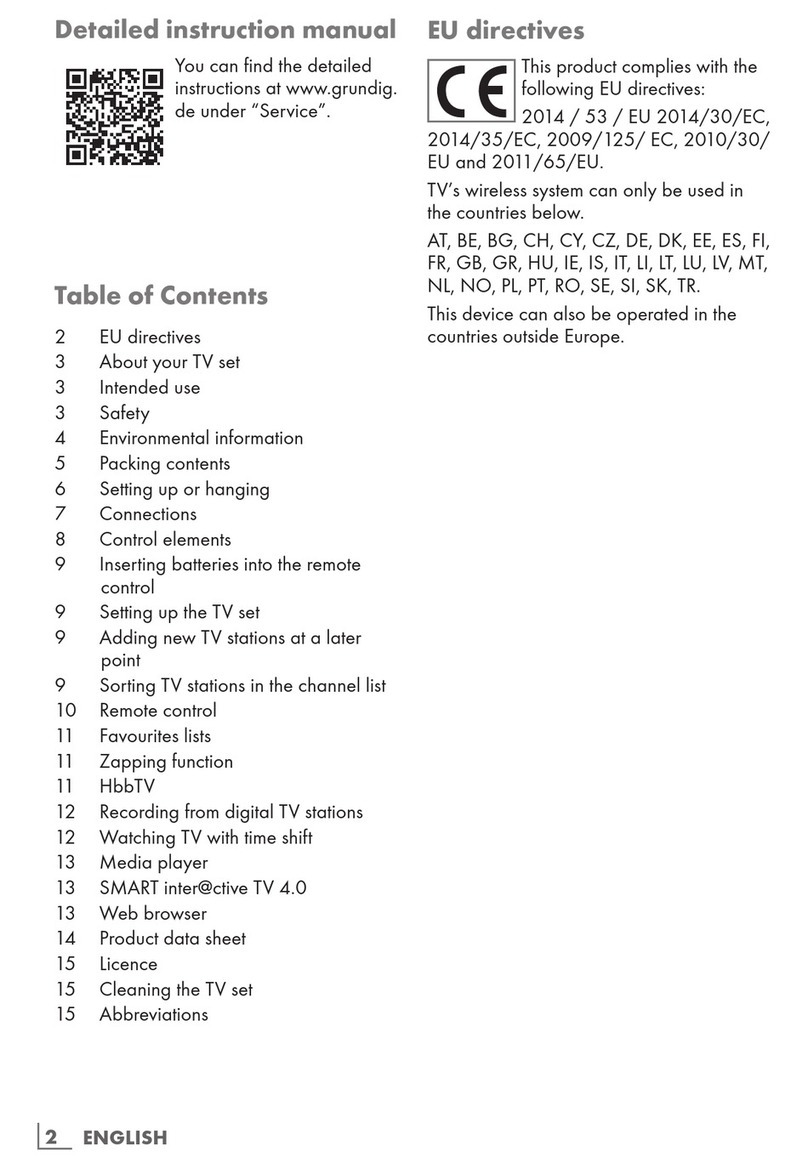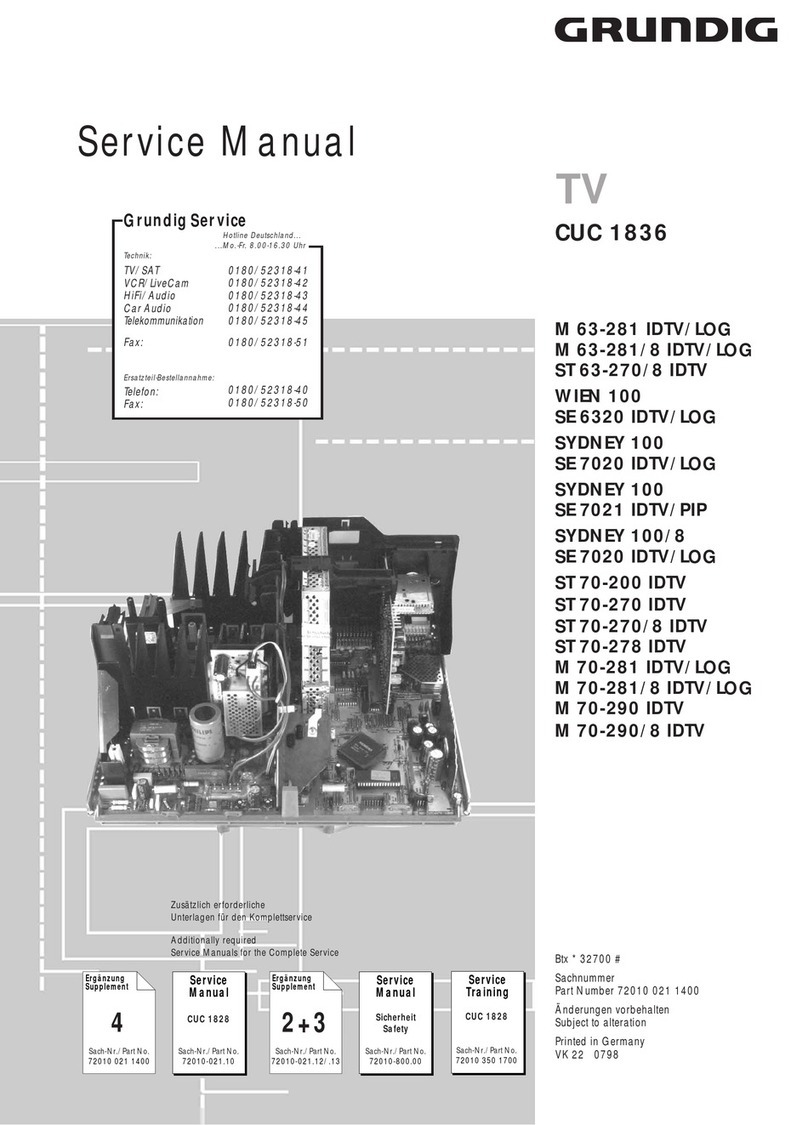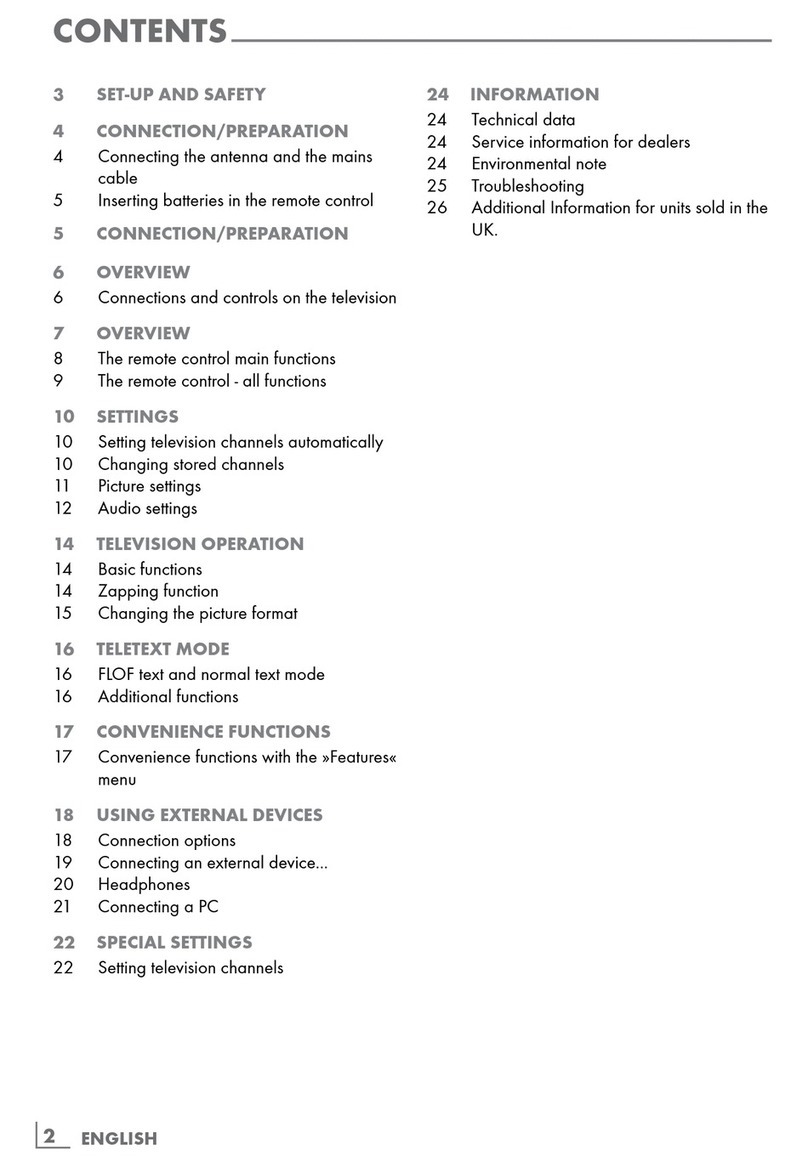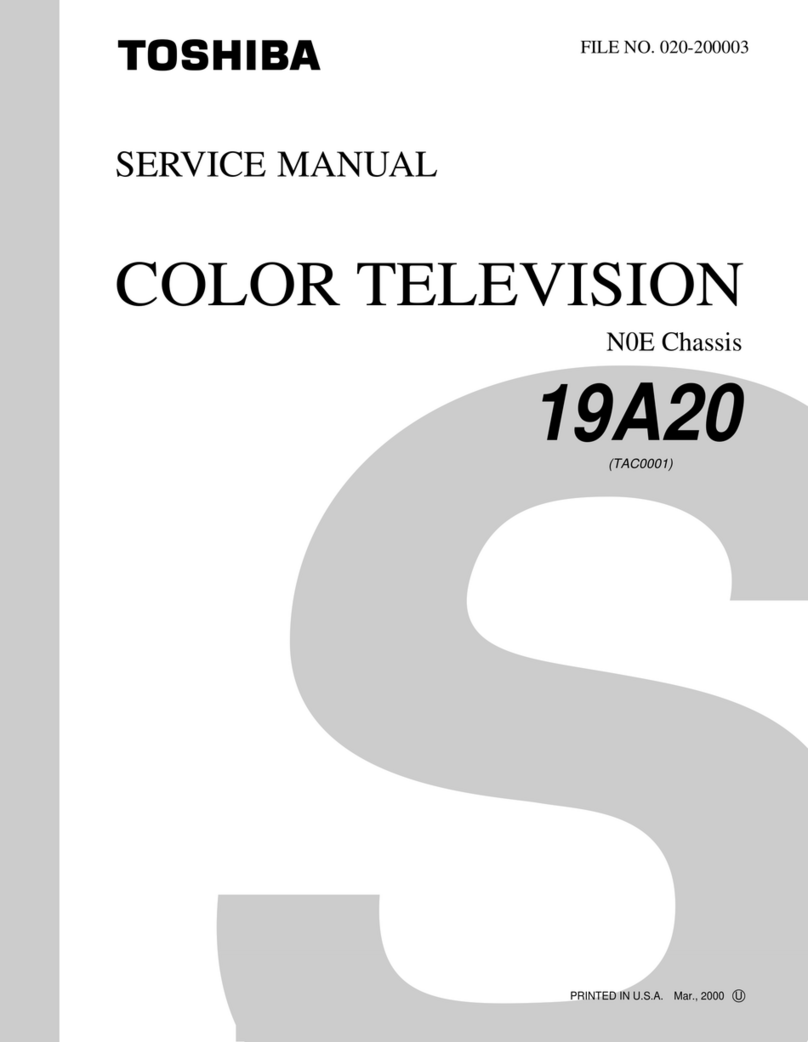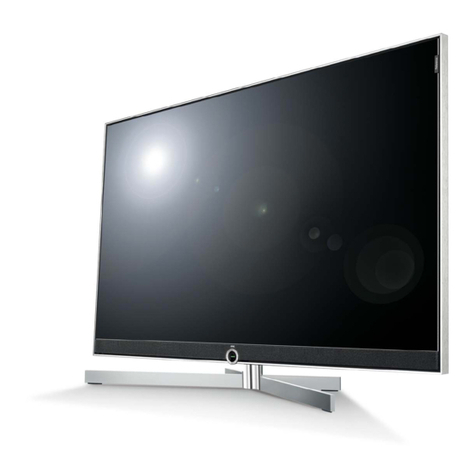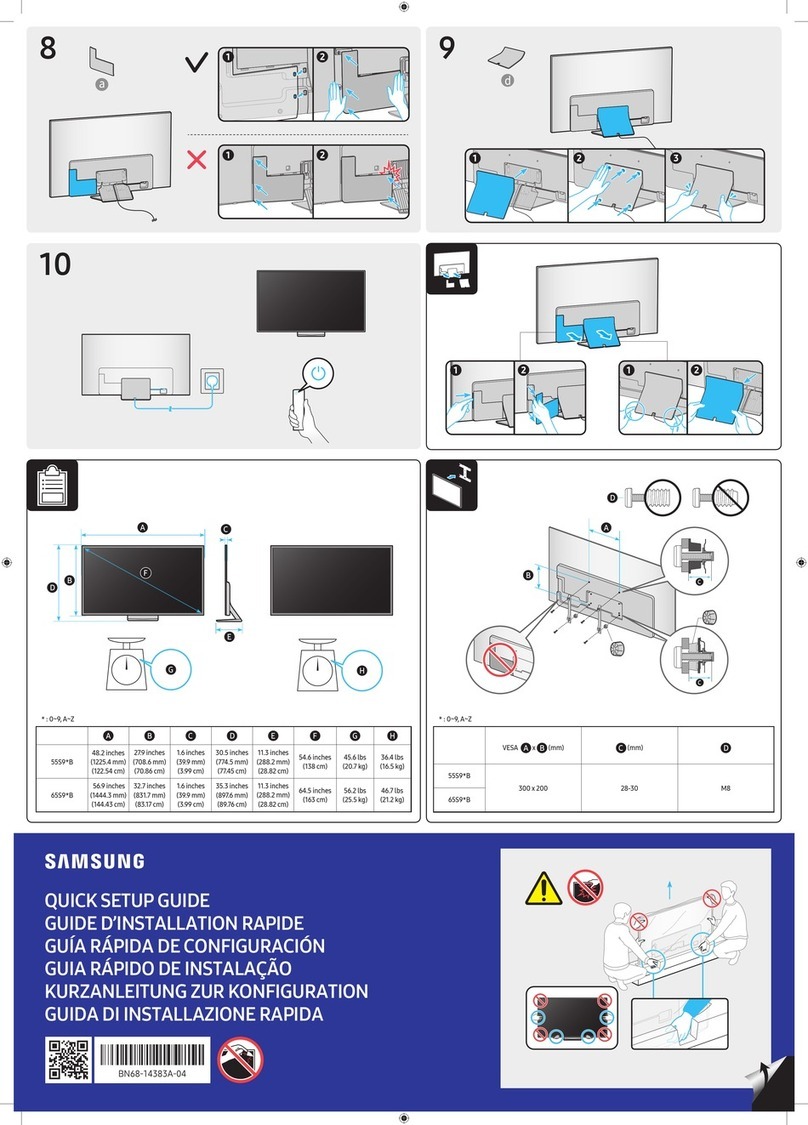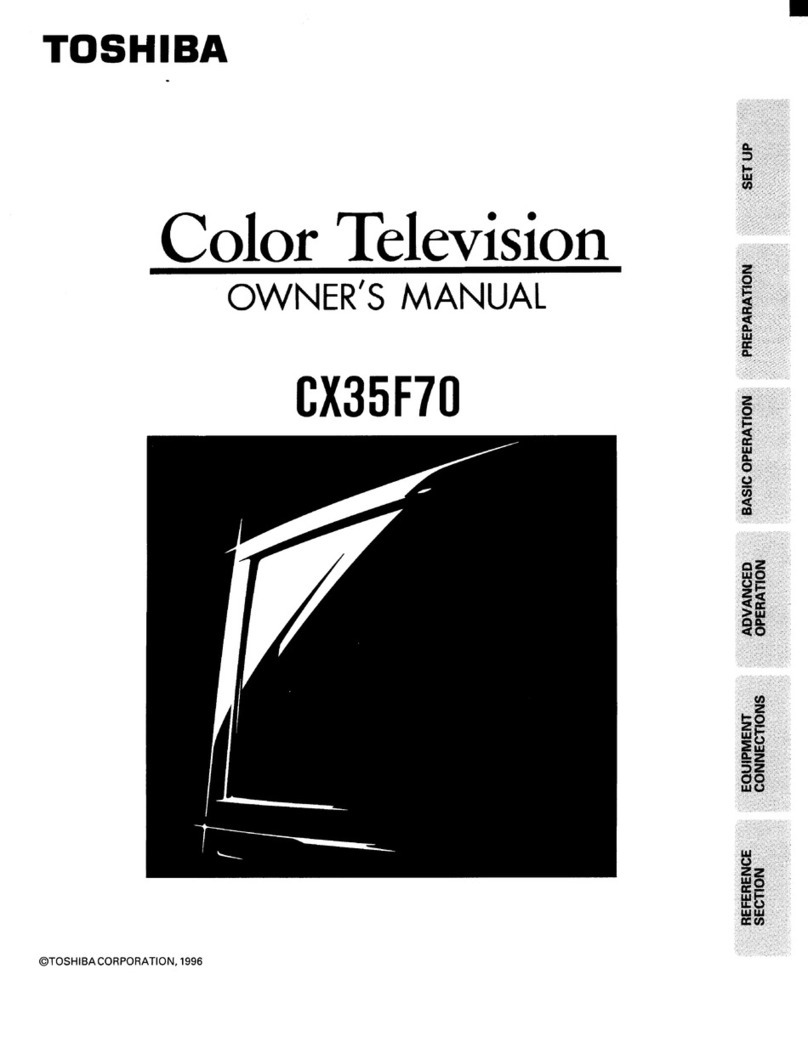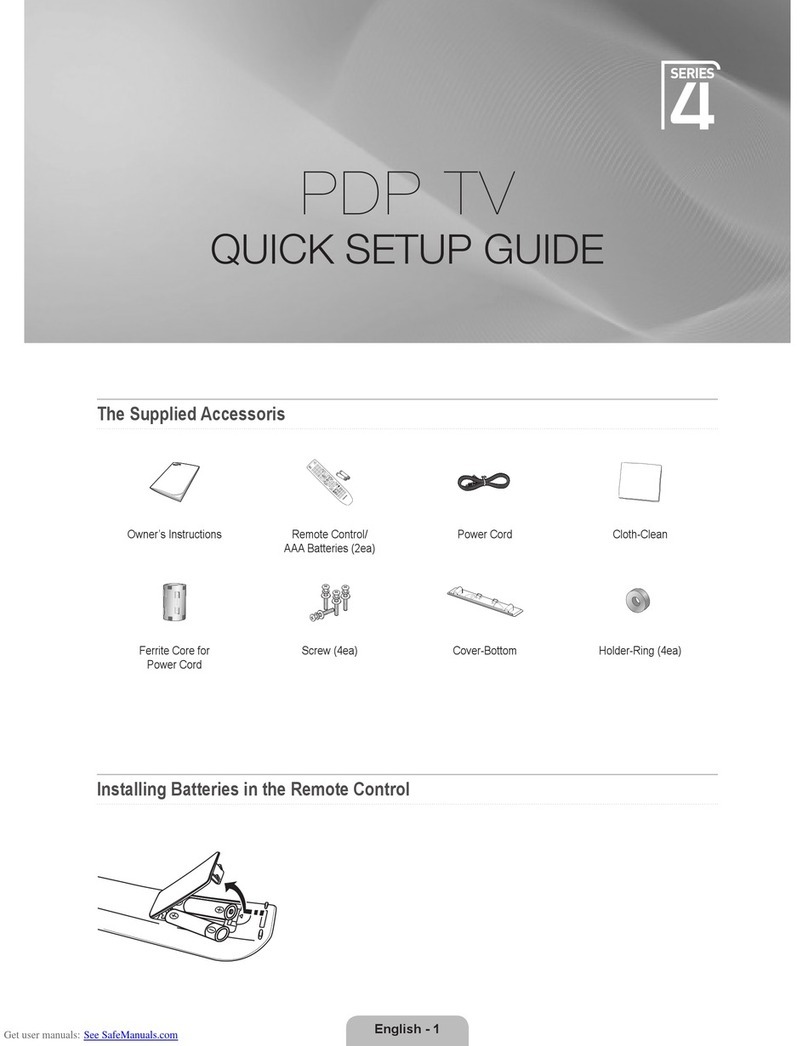
Circuit Description ST 03
2 - 2 GRUNDIG Service
whichisintegratedontotheIC800.Thesyncseparationandtimebase
circuits are also integrated on to this chip. Incoming video is stripped
of its line and field sync pulses. The horizontal and vertical syncs are
then derived from the composite sync waveform.
6. Time Base Generator
Thelinesyncisfedtothelinetimebasegeneratorcircuit.Thelinetime
baseis derivedfromthe masterclockoscillator anddividercircuit. The
linepulses fromthedivider arefedintobothPLLcircuitsalong withthe
sync and flyback pulses. These combine together to produce the line
driveforthelineoutputcircuit.TwoPLLtimeconstantsareusedtogive
good lock for both fixed, gen-locked syncs, such as from terrestrial
transmission and from weak or variable sync such as VCR.
All controls for the line time base generator are integrated and are
accessedviatheI2CbusundermicrocontrolfromIC500.Theseareset
up in the factory by a test software.
6.1 Vertical Time Base
The vertical time base is again generated on chip by the use of the
master clock in conjunction with the separated field sync. The divider
circuitcount is controlled by thesyncpulse.The counter produces the
pulsestogeneratethe vertical ramp which is in turn fed toa bufferand
then fed out to the field output circuit.
Inthe event ofnovalidsync being presentthenadirect injection mode
isusedtocontinuethefunctionoftherampgenerator.Thisdirectmode
then enables vertical scan to be maintained in the event of no signal
being present.
7. RGB Drivers
The RGB video signals are fed out on IC800-(17), -(18), -(19). These
signalsarethenbufferedbytheemitterfollowercircuitsTR801,TR802
and TR803 before being fed to the tube base panel. External RGB
signalsare also abletobefed intothisICon pins22,23and 24. These
pinsare normally fed withRGBlevelsof 700mVpp signals fornominal
display. The choice of display is determined by the switch pin on
IC800-(21). This is controlled by the output of the teletext chip blank
signal or the blanking signal from the microcontroller for on screen
graphics display or the PERITEL pin 8.
7.1 Auto Grey Scale Tracking
The system also incorporates an automatic grey scale tracking sys-
tem. This removes the need for manual adjustments to set up back-
ground luma levels in high-light and low-light areas on CRTs.
Forcorrecttrackingtheautogreyscaleworksontheprincipaloftaking
measurementsof the dark current during thefieldblankingperiodand
also inserting a peak white signal in that period and setting those
thresholdstocontroltheoutputstagesofthechip.Thisensuresthatthe
tube characteristics are constantly being matched by the video output
sothatgreyscaleandpicturecolourintegrityisconstantlymaintained.
7.2 Beam Limiter
The RGB output gains are also affected by the beam limiter circuit on
IC500. This is to prevent the tube from being damaged or its life
expectancy being shortened by excessive beam current.
Thesensingof the beam current is performedatthebottomendof the
DST secondary supplying the EHT focus and G2 voltages to the tube.
The reference point is pin 7 on the DST, this current is sensed as a
changeinvoltagedevelopedacrossresistorsandfedtothebeamlimit
sense IC800-(9). This voltage is measured against a reference which
represents maximum beam current. When the sensing level exceeds
the reference then the gain on RGB output amps is reduced, thereby
reducingthebeamcurrent.Saturationcontrol,brightnessandcontrast
are adjusted via the remote control but the nominal levels are preset
inthefactorybytheI2Cbususingthemicrocontrollerandtestsoftware.
8. System Microcontroller (IC500)
TheST6365 is adedicatedmicrocontrollerfor TVcontrolapplications.
Ithassuchfeaturesasdedicatedvoltagesynthesistuningcontrol,AFC
control and on-screen graphics display generator. Also it has a
dedicated infrared remote control serial data input. This microcontrol-
lerhasadedicatedI2CportforcommunicationtoothercontrollableICs.
The controller clock frequency is 8MHz and this clock speed is
achieved by connecting an 8MHz ceramic resonator across the
oscillator pins 31 and 32 with two 100pF capacitors, C507 and C508,
to ground from each pin. The timing for all functions performed by the
microcontroller including I2C bus are taken from this clock.
8.1 Voltage Synthesis
Theon-chipvoltagesynthesistuningperipheralhasbeenintegratedto
allow the generation of a tuning reference voltage. The peripheral is
composed of a 14 bit register that represents the tuning voltage at
pin 1. This voltage is generated using pulse width modulation and bit
rate multiplier techniques.
The 14 bit counter gives 16384 steps which allow a resolution of
approximately2mVoveratuningvoltagerangeof32V.Coarsetuning
isachievedbyPWMofthe7mostsignificantbitsofthe counter, whilst
fine tuning is achieved by BRM (Bit Rate Multiplication) of the 7 least
significant bits of the counter.
The resultant digital pulse train is fed into the base of TR410. This
invertsthepulsetrainwhichisthenfedintothe3stageintegratorwhich
integrates the pulse train into a DC voltage.
8.2 AFC Control
The output of the voltage synthesizer can be changed either by the
remote control or the local keyboard. The tuner oscillator is kept on
frequency by the application of AFC. The AFC acts on the voltage
synthesizervia a feedbackpath.TheAFC is generated byIC400.This
voltage is fed back to the AFC pin 9 on the controller. As the tuner
oscillator drifts either up or down so the signal applied to IC400
deviates from the optimum. As a result an error voltage appears on
IC400-(2). This voltage can be either positive or negative with respect
to the optimum voltage. This error voltage is fed to pin 9 of the
microcontroller. This voltage is then digitized. If the digital value is
optimumthennochangeismadetothesynthesizeddigits.Ifthedigital
value is either side of optimum, then the resultant AFC value is either
added to or subtracted from the synthesizer value.
8.3 Analog Controls
Pins2and5onthemicrocontrollerarePWMD-Aconverters.However,
these are only 6 bit resolution which is perfectly acceptable for the
analog functions they perform.
TheD-Aonpin2isusedastheelectronicvolumecontrolforthesound.
TheD-Aonpin3isusedforthemulti-levelvoltagecontrolforaudioand
video switching of IC400 and IC450. The D-A on pin 4 is used to
produce the threshold level for the AGC to the tuner. The final D-A on
pin5isasyetuncommitted.Themicrocontrollerhas3I/Oportsaswell
as the dedicated peripheral pins, some of the I/O ports also have
dedicated functions and are listed as their dedicated function, i.e. the
AFC on pin 9 is bit 3 of port B.
8.4 Key Pad Interface
Bits 0-2 and bits 4-5 of port B provide the matrix for the crosswire
keypad.
8.5 Sync Detector/Mute Control
Bit 6 of port B is a sense pin which mutes the sound when text is
displayedandincomingsignalis lost. Normally the microcontroller will
mute the sound when the aerial is removed or tuning is off station
because it detects no line lock coincidence.
However, in out-of-hours sync mode, the text chip set detects lack of
sync coincidence and mutes the sound. Bit 0 on port A senses the
status of pin 8 on the peri connector for switching video and sound to
incoming signals on the peri connector.
8.6 Peritel Monitor/OSG Control
Bit 1 on port A monitors the blanking signal on pin 16 of the peri
connector and also the blanking signal from text and OSD sources.
Bit 2ofportAactsasthecontrollinefortheswitchthatactsonSAW450
asdescribedinsection2.Bit3isusuallylinkedtoground, however for
System PAL BG/SECAM L/L’ this link is omitted.
8.7 Band Switching and LED Driver
Bits4to6ofportAarethebandswitchingoutputswhichdrivetheband
switches.Bit7 of port A is connected tothe LEDD500.Pins22and25
are OSG display pins whilst pins 26 and 27 are the sync input pins.
Pin33 is the hardwarepower-onreset. Pin 34 istheSECAM L/L SAW
selector switch. Pin 35 is IR input line. Pin 36 is BG/DK system select.
8.8 Standby Control/ Sound Mute
Pin37isavailableasastandbylineforexternaluse.Innormalstandby,
thecontrollershutsdownallcircuitsthatprovidedrivetooutputstages,
thereby placing the system in quiescent current consumption mode.
Pin39isthesoundmuteoutputwhichdrivesthesoundmutetransistor
TR5 and TR7. Pins 40 and 41 are the dedicated I2C bus.



